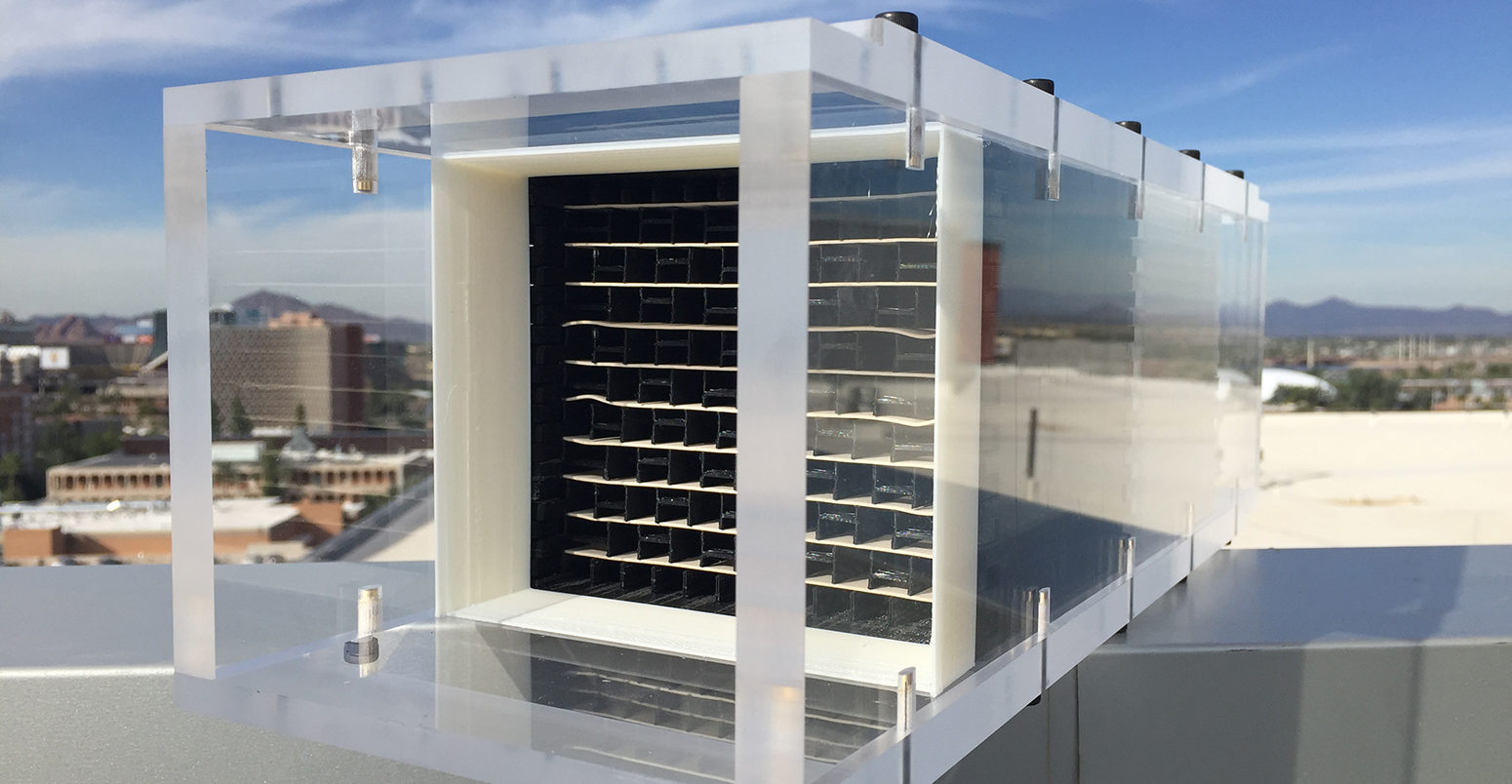
Guest post: Who will deliver the negative emissions needed to avoid 2C warming?
Multiple Authors
10.30.17Multiple Authors
30.10.2017 | 7:00amDr Glen Peters is a senior researcher at the CICERO Center for International Climate Research in Norway, and Dr Oliver Geden is head of the EU/Europe Research Division at the German Institute for International and Security Affairs in Berlin, and research associate at the Institute for Science, Innovation and Society at the University of Oxford.
With every year that global carbon emissions don’t fall, it becomes more likely that human society will need to turn to more unconventional options to slow the accumulation of CO2 in the atmosphere.
“Negative emissions”, also known as “carbon dioxide removal” (CDR), refers to a group of approaches and technologies that take CO2 from the atmosphere and store it on land, underground or in the oceans.
They first came under intense scrutiny following the publication of the Intergovernmental Panel on Climate Change’s (IPCC) fifth assessment report in 2013. The criticism mainly focused on the conceptual use of untested methods of CDR to keep global warming below 2C above pre-industrial levels in model simulations, the potential risks of deploying CDR technologies at scale, and the role of science in climate policy negotiations.
The political implications of large-scale CDR have remained largely out of the debate. At COP21 in Paris in December 2015, governments not only agreed on limiting temperature increase to “well below 2C”, they also set a target of reaching a balance between emission sources and sinks in the second half of the century. A “net-zero” target may have political advantages, but it also necessitates CDR.
Despite all the bluster in the scientific community on CDR, there has been no debate on the one issue that usually dominates UN climate negotiations – differentiation. This is the level of responsibility that rich and poor nations will take on in the global fight against climate change.
But the big questions still remain: which countries are going to start CDR first? And, which countries will deliver the bulk of the CDR?
Entering negative territory
While some advocate for 100% renewable scenarios, it is likely that cost-effective reduction of global greenhouse gas emissions will require a broad mix of technologies.
There may be some activities where it is simply too expensive to mitigate completely. These “residual emissions” may occur in industry (e.g. metals production), transport (e.g. aviation), and agriculture (e.g. methane from rice and cattle). Integrated Assessment Models (IAMs) also indicate that it is cheaper to have large-scale CDR in the future, than to have deeper mitigation now.
Love it or hate it, it may be that CDR is simply unavoidable if society wants to stabilise temperatures. If one can accept that we need CDR, the real debate becomes at what scale.
To assess the scale of CDR, and later the regional distribution, we compared the output from four cost-optimal IAMs from the AMPERE project. IAMs provide CDR using afforestation and Bioenergy with Carbon Capture and Storage (BECCS), but we focus on BECCS since the AMPERE database does not separate afforestation from deforestation and IAMs do not currently include other forms of CDR.
The figure below shows simulations of cost-effective mitigation options in the different IAMs: BECCS starts as early as 2020, reaches 10-20 gigatonnes of CO2 (GtCO2) per year in 2100 (25-50% of current annual emissions), and increases to 400-800GtCO2 by 2100 – a size comparable to the remaining carbon budget.
The land areas required for such large-scale CDR would be the size of India, or even larger.
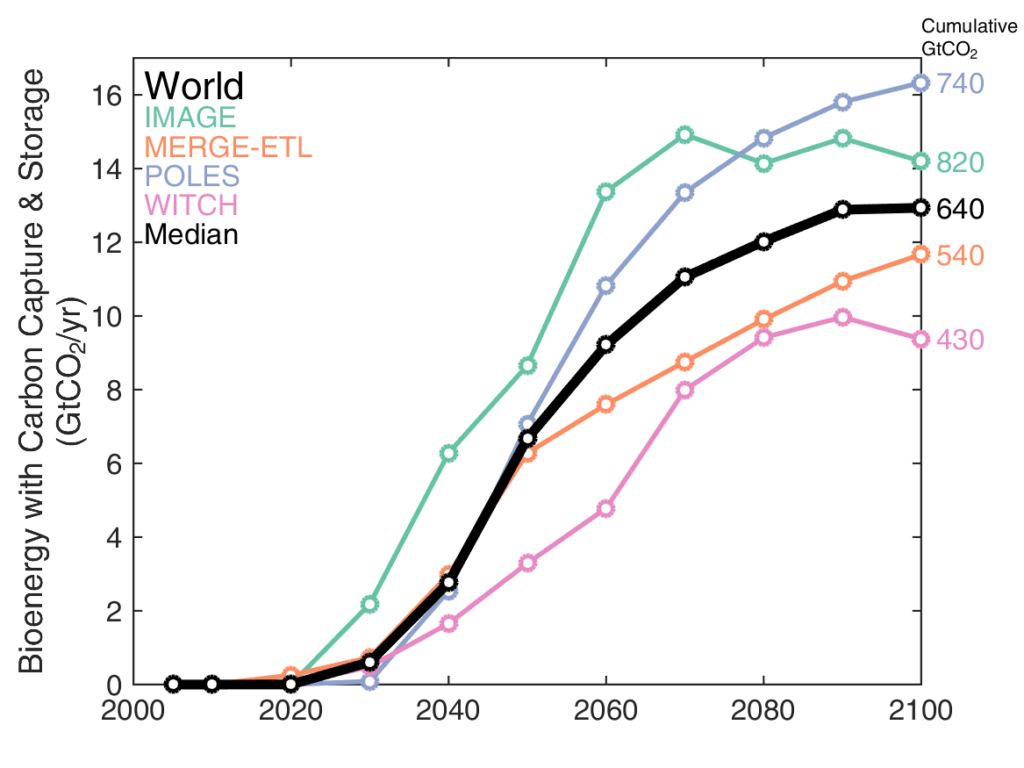
Bioenergy with Carbon Capture and Storage (BECCS) in cost optimal 2C scenarios from the AMPERE project. The cumulative emissions at the end of the century (right axis) are about the same size as the remaining carbon budget in 2015. At the global level, there is little variation between the scale of BECCS across models. Source: AMPERE database, with own calculations, adapted from Peters & Geden (2017).
Distribution among countries and sectors
Most discussions of CDR have been at the global level. This is an unhelpful focal point, as individual actors must deliver CDR. A suitable compromise is the national level, which is particularly useful for climate policy negotiations.
To assess the potential political conflicts, we compared the level of BECCS from the four cost-optimal IAMs at the regional level. Across the model projections, China, the US, EU and India tend to take the lead in ramping-up BECCS until 2050, with cumulative values of 5-10GtCO2 up until 2050. These countries also provide the largest cumulative contributions over the 21st century. As shown in the figure below, the median of all models suggests China contributes 80GtCO2, the US 60GtCO2, India and the EU 50GtCO2, Brazil 40GtCO2 and Russia 30GtCO2 – but they still represent less than half of the cumulative global CDR total.
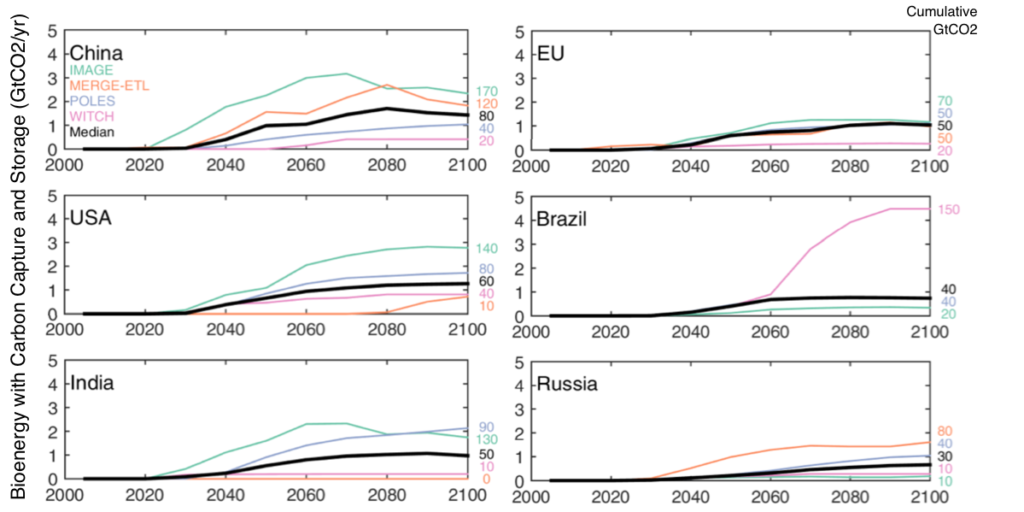
Regional variation in BECCS in cost optimal 2C scenarios from the AMPERE project. Across models, there is a large variation in the scale of BECCS at the country and regional level. Modelling results could become a topic of political discussion as countries jostle to determine the amount of BECCS they could feasibly offer to the global total. Source: AMPERE database, with own calculations, adapted from Peters & Geden (2017).
The scale of CDR also means that reducing emissions by 100% is not sufficient. Countries need to have emission reductions greater than 100% and, therefore, go below zero. Under “common but differentiated responsibilities”, it could be expected that industrialised countries will go below zero earlier than emerging economies and developing countries.
Emerging and developing countries are likely to demand that industrialised countries invest more in CDR, whilst they themselves might not even reduce their own emissions to zero.
The output from the IAMs gives an indication of cost-optimal pathways, but these may deviate substantially from politically-optimal pathways. Even if an operational global carbon trading system could feasibly transfer costs between countries to make it politically palatable, it is likely that countries such as India would not see it as fair.
India and others could argue that they should not provide CDR at a scale like the EU and the US, countries who have a much larger historical contribution to current climate change.
Further, since different IAMs lead to a variety of CDR outcomes, in a political negotiation on CDR commitments, it is likely that countries will put forward modelling results that suit their strategic objectives. For example, Brazil might argue the modelling assumptions behind one particular model overestimate the BECCS potential in Brazil, other countries may argue the opposite.
Distribution concerns also apply at the sector level, see the figure below. Scenarios indicate that the power generation (green) will provide all the CDR, while other sectors – including industry (orange), transport (blue) and residential and commercial (pink) – continue with positive emissions. The power sector has to do more mitigation, while other sectors continue with positive emissions. It is not good enough for the power sector to get to zero emissions.
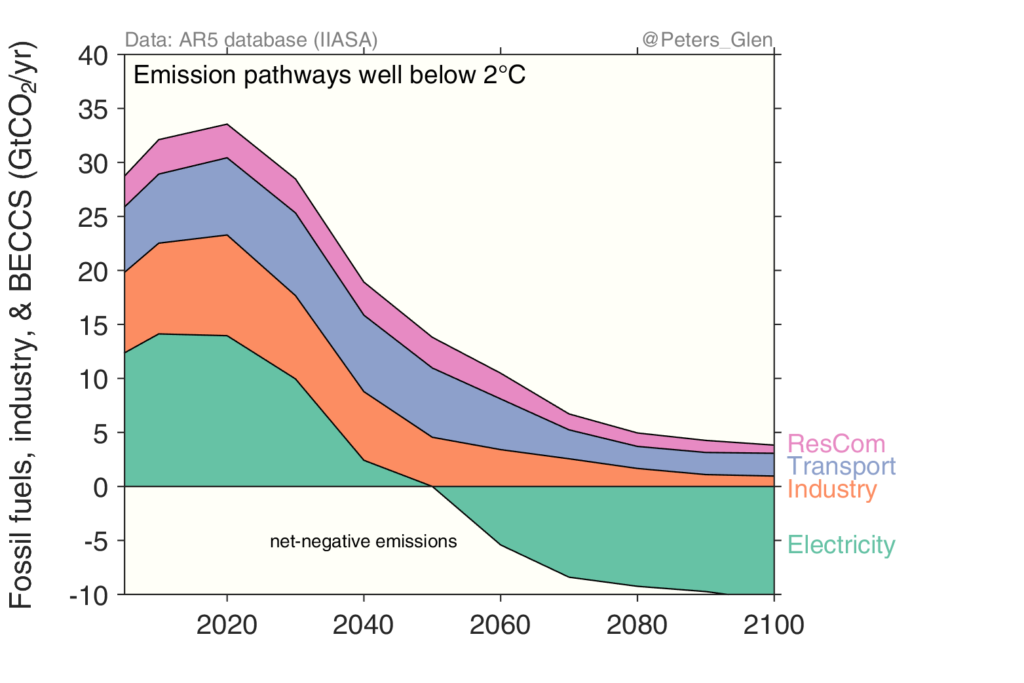
Sector-level emissions in cost-effective scenarios with a likely chance of keeping below 2C assessed in the IPCC fifth assessment report (Chapter 6 of Working Group 3). The median of about 120 scenarios is shown here to illustrate the sector-level results. Only electricity generation has net-negative emissions, from bioenergy with carbon capture and storage. ResCom is Residential and Commercial. Source: IPCC AR5 scenario database, but with own calculations.
Incentive and accounting problems.
The amount of CDR at the regional level will depend on how climate policies incentivise business to develop and deploy the necessary technologies.
Within an IAM, investment decisions are made with long-term, stable and high carbon prices, perfect knowledge of technology costs, and perfect coordination along the international supply chain, leading to zero risk of investments failing. Reality is more complex.
Generous government support in the late 2000s was not sufficient to propel large-scale carbon capture and storage, with carbon prices being too low and unstable, and public opposition too high.
Bioenergy has also been controversial, with continued debates on its carbon neutrality and climate benefits. This further compounds the risks of BECCS. Unless the climate benefits of BECCS can be assured, then it is unlikely it will ever go beyond a boutique application.
Reporting emissions from bioenergy has always been a challenge, and these issues are further compounded when including carbon capture and storage. CO2 emissions along the BECCS supply chain can be separated into four key components, as shown by the figure below, but the way they are reported is far from simple.
The CO2 from bioenergy use is currently reported as a memo in the official greenhouse gas inventories reported to the UNFCCC and, thereby, treated as carbon neutral in the energy sector (white bars). But the CO2 emissions from bioenergy only appear in the land sector if there is a change in carbon stocks on land (shown as zero in the figure). Further, the land sector covers other activities in addition to bioenergy, potentially masking land use change associated with bioenergy. Another complication is that the CO2 emissions associated with supplying biomass (black bar) may be counted as coming from the energy sector if it is based on fossil fuel use, and therefore be aggregated as a part of total fossil fuel use. And finally, the CO2 captured and stored from bioenergy use (grey bar) is reported separately, but it is also aggregated with all forms of carbon capture and storage.
The total emissions from the BECCS supply chain is the sum of these four components, but because they are all reported separately and often aggregated with other components, it is not possible determine the net emissions for a given BECCS system directly through current emission reporting.
The BECCS supply chain may also span several countries. It could be that bioenergy produced in one country (e.g. Cameroon) would be exported to another (e.g. UK) for combustion and CO2 capture, and then the captured CO2 exported to a third country (e.g. Norway) for permanent storage. Unless consistent reporting is applied to all these countries, then the reporting system does not work.
Effective reporting for the complexities of the land sector have eluded scientists and policymakers for decades. Universal and consistent reporting will partially solve the problems. However, reporting needs be disaggregated and linked, so that bioenergy use in one country can be linked to a specific bioenergy harvest in potentially third countries. Without modifications to the current reporting system, it is difficult to assess carbon neutrality of bioenergy crops confidently – particularly when they are traded internationally.
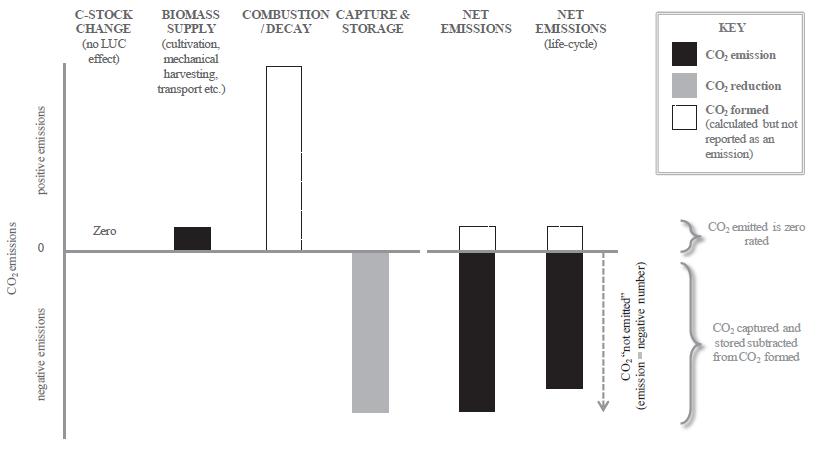
A schematic of an accounting system for BECCS. Bioenergy is currently reported without emissions in the energy sector (white boxes), but associated emissions are reported in the land sector based on stock changes. For the accounting system to work, it requires consistency across all countries. Source: Zakkour et al. (2014)
The detailed carbon accounting system would need to be coupled to a system of financial transfers to incentivise behaviour. The entire system would require independent measurement, reporting and verification, and would have to be robustly applied across countries with vastly different motives and governance levels. CDR may interact with existing policy incentives, such as effectively raising emission caps and lowering carbon prices. Indeed, CDR may need new policy instruments, effectively a direct payment to reward the removal of carbon from the atmosphere.
While complex accounting systems can be devised, the governance challenges to incentivise CDR would require resolving accounting and financial issues that remain sticking points in existing domestic and international policy negotiations. Unless actors can get the necessary incentives, CDR will never go beyond small-scale applications.
Political conversation about CDR
It has become clear that staying “well below 2C” will require the large-scale application of CDR. This is not going to happen, unless we catalyse a political conversation about CDR. We identify three key areas that need more focused discussion to go beyond boutique applications and support CDR at the required gigatonne scale:
- Countries should begin negotiating differentiated CDR responsibilities, perhaps initiated by the “Facilitative Dialogue” in 2018, to indicate potential pathways to net-zero emissions and volumes of CDR that may be achieved
- Develop a detailed and functional system of accounting, supported by measurement, reporting, and verification, to track carbon and financial flows along the international CDR value chain
- Develop policy portfolios capable of incentivising business to research, develop and deploy the necessary technologies.
If a political discussion about CDR does not start now, then time will tick by and CDR will become the moral hazard some have feared.
Peters, G.P. and Geden, O. (2017) Catalysing a political shift from low to negative carbon, Nature Climate Change, doi:10.1038/nclimate3369
-
Guest post: Who will deliver the negative emissions needed to avoid 2C warming?

